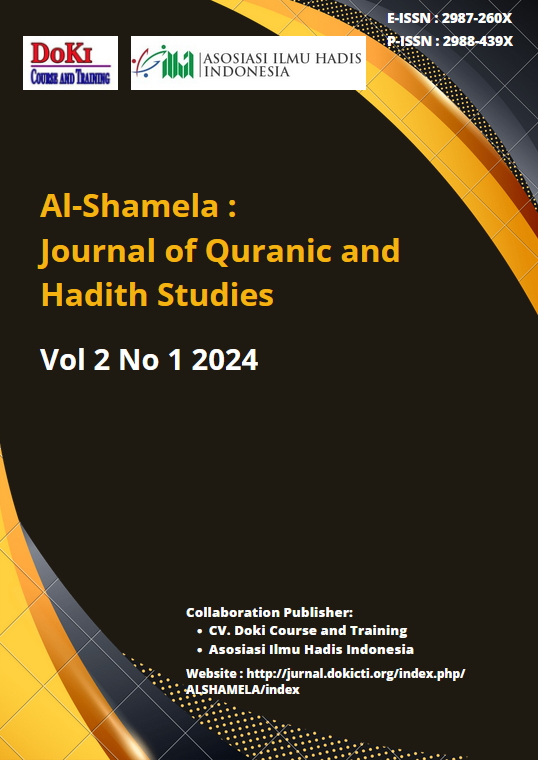Emulating Prophet Muhammad's Hairstyle As a Form Of Ittiba’ Sunnah By Muslim Youths
DOI:
https://doi.org/10.61994/alshamela.v2i1.412Abstract
Appearance is an important thing to be considered by every group. For a man, having a neat hairstyle can give added value to the man. But who would have thought that in Islam there are several hairstyles that are recommended and disgraced in accordance with the teachings of the Prophet SAW. The purpose of this study is to discuss the nature of hair and the way the Prophet combs his hair, as well as the opinion of the Ulama regarding ittaba'. This research uses a type of qualitative research using the library research method or library study analysis. The literature study method is a method of collecting some data obtained from trusted sources or literature, both in the form of hadith master books, journals and websites. The results of this study indicate that the length of the Prophet's hair ranged from reaching both sides of the ear and both shoulders when he did not shave it. The Prophet was not fixated on one state of hair although the most serious state was to leave it short and neat. The Prophet preferred the hairstyle of the Jews and Christians which was left loose. In addition, the Prophet also imitated the hairstyle like the tradition of the polytheists which was split in the middle. This study found that the different lengths of the Prophet's hair mentioned in the hadith are very important to make his hair neat. Therefore, if one wants to follow the Prophet's hair Sunnah, they can shave, comb, or tie their long hair.
References
Admin. “Istilah–istilah Dalam Periwayatan Hadits.” 08/04/13, 2013.
Ahmad bin Hanbal. Musnad Ahmad bin Hanbal. 1 ed. Arab Saudi: Darussalam, 2013.
Ahmad, Tafsil Saifuddin. “Mushannaf Ibnu Abi Syaibah.” An-Nahdlah 7, no. 1 (2020): 121–40.
Al-Mizzi, Jamaluddin Abi Al-Hajjaj Yusuf. “Tahdzibul Kamal Fi Asma Al-Rijal.” diedit oleh Bashar Awwad Ma’ruf, 1 ed., 371. Beirut: Al-Muassasah Ar-Risalah, 1983.
———. “Tahdzibul Kamal Fi Asma Al-Rijal.” diedit oleh Bashar Awwad Ma’ruf, 1 ed., 365. Beirut: Al-Muassasah Ar-Risalah, 1987.
———. “Tahdzibul Kamal Fi Asma Al-Rijal.” diedit oleh Bashar Awwad Ma’ruf, 1 ed., 461. Beirut: Al-Muassasah Ar-Risalah, 1992.
Al-Qazwini, Abi Abdullah Muhammad bin Yazid Majah. Sunan Ibnu Majah. Yordania: Baitul Afkar Ad-Dawaliyah, 2014.
Al-Sajistani, Abi Dawud Sulaiman bin Asyats. Sunan Abu Dawud. Yordania: Baitul Afkar Ad-Dauliyah, 2015.
Anggraeni, Dewi, dan Siti Suhartinah. “Toleransi Antar Umat Beragama Perspektif KH. Ali Mustafa Yaqub.” Jurnal Online Studi Al-Qur’an 14, no. 1 (2018): 59–77. https://doi.org/10.21009/jsq.014.1.05.
Aprilina. et al. “Sistem Kredit Dalam Shopee Paylater Perspektif Hadis”. Al-Shamela: Journal of Quranic and Hadith Studies 1, no. 2 (2023). https://doi.org/10.61994/alshamela.v1i2.120.
Deni Putri Kusumawati. “Hukum Seputar Belahan Rambut.” 18/04/18, 2018.
Hanifa, Mia Syahrina, Ali Masrur, dan Badri Khaeruman. “Kriteria Kesahihan Hadis Menurut Nashiruddin Albani dan Ahmad Al-Ghumari.” Jurnal Riset Agama 2, no. 2 (2022): 185–203. https://doi.org/10.15575/jra.v2i2.17013.
Haq, Ahmad Yusronil. “The Study Of Misrepresented Hadiths On The Internet About Muslim And Non-Muslim Relationships.” Nabawi: Journal of Hadith Studies 4, no. 1 (2023). https://doi.org/10.55987/njhs.v4i1.97.
Hardiyanti, Sri. “Perancangan Aplikasi Mobile Catalog Model Rambut Dengan Menerapkan Algoritma Crochemore Perrin”, KOMIK (Konferensi Nasional Teknologi Informasi dan Komputer) 3, no. 1 (2019).
Hendri F Isnaeni. “Gaya Rambut Nabi Muhammad.” 14/05/19, 2019.
Imam Abi Abdullah Muhammad bin Ismail Al-Bukhari. Shahih Bukhari. 1 ed. Damaskus: Daar Ibn Katsir, 2002.
Imam Abi Husain Muslim bin Hajjaj bin Muslim Al-Qusairi An-Naisaburi. Shahih Muslim. 2 ed. Arab Saudi: Darusssalam, 2000.
Imam Al-Hafidz Muhammad bin Isa bin Saurah At-Tirmidzi. Sunan At-Tirmidzi. 1 ed. Riyadh: Maktabah Al-Ma’arif, 2012.
Jamal Al-Din Abi Al-Hajjaj Yusuf Al-Mizzi. “Tahdzibul Kamal Fi Asma Al-Rijal.” diedit oleh Bashar Awwad Ma’ruf, 1 ed., 476. Beirut: Al-Muassasah Ar-Risalah, 1982.
———. “Tahdzibul Kamal Fi Asma Al-Rijal.” diedit oleh Bashar Awwad Ma’ruf, 1 ed., 330. Beirut: Al-Muassasah Ar-Risalah, 1985.
———. “Tahdzibul Kamal Fi Asma Al-Rijal.” diedit oleh Bashar Awwad Ma’ruf, 1 ed. beirut: Al-Muassasah Ar-Risalah, 1992.
Prasetya, Bagus Yustinus. “Representasi Perlawanan Citra Negatif Rambut Gondrong Dalam Video Situasi Komedi Youtube Channel May I See Bertajuk “Cowok Gondrong Vs Cowok Basic” (Analisis Semiotika Roland Barthes)”, Tesis, UPN Veteran Jatim, 2021.
Suryadilaga, Muhammad Alfatih. “Pembacaan Hadis Dalam Perspektif Antropologi.” Alqalam 34, no. 2 (2017): 229. https://doi.org/10.32678/alqalam.v34i2.1063.
Tan, Harry Hartanto. et al. “Perancangan Buku Ilustrasi Tentang Beragam Sejarah Gaya Rambut Tahun 1990-2016”, Jurnal DKW Adiwarna 1, no. 8 (2016).
Widodo, Yohanes Bowo, Sondang Sibuea, dan Achmad Rivaldi. “Rancang Bangun Aplikasi Sistem Pakar untuk Pemilihan Model Gaya Rambut Pria Menggunakan Metode Forward Chaining.” Jurnal Teknologi Informatika dan Komputer 9, no. 1 (2023): 558–73. https://doi.org/10.37012/jtik.v9i1.1622.
Downloads
Published
Issue
Section
License
Copyright (c) 2024 Wafa Satria Kamil, Faradelia Mahmudita, Rikana Nur Lailatul Ramadhani, Ahmad Saddad (Author)

This work is licensed under a Creative Commons Attribution-NonCommercial 4.0 International License.











